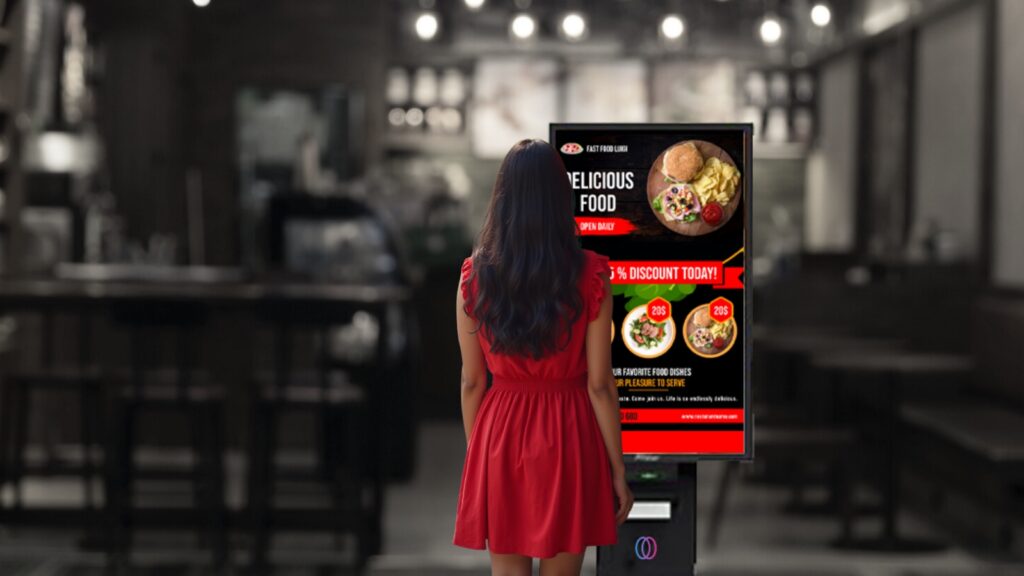Market forecasts: Did you know that the estimated value of Self-Service Kiosks across all industries, including Quick-Service Restaurants (QSR), is expected to grow at 10.5% CAGR to reach $92.8 billion (USD) by 2024?
Fast food giants like Burger King, McDonald’s and Wendy’s explored the domain of restaurant kiosk systems way back in 2006, and the adoption of self-service technology in the food industry, especially QSRs, has now become an industry-wide trend. Statistics reveal that over 78% of QSR customers prefer kiosks for ordering, and 82% would choose a QSR with kiosks over those that don’t, given the advantage of improved ordering experience, allowing customers to place or customize their orders quickly, comfortably and conveniently sans human error.

Taco Bell Self-Ordering Kiosks
Coming to demographics, 91% of GenZs and 80% of millennials are likely to visit restaurants with kiosks rather than standing in queues for conventional cashiers, leaving no doubt that self-ordering kiosks in QSRs are significantly transforming the way customers interact with fast-food establishments.
Taco Bell’s Tryst With Self-Ordering Kiosks
Considering obvious benefits like optimized staff, enhanced operational efficiency, and significant revenue increase, Taco Bell, one of the most prominent players in the QSR sector, has embraced this digital shift with its very own restaurant kiosk systems designed for self-ordering.

Taco Bell self Ordering Kiosks
Rolled out in 2019 as part of their ‘All Access’ initiative, Taco Bell’s self-ordering Kiosks successfully catered to customers who were ‘willing to try different things’ by offering digital access to a diverse and, more importantly, customizable menu.
With this impactful rollout, Taco Bell was honored by The Interactive Customer Experiences Association with the 2019 Elevate Award for best restaurant kiosk systems.
Benefits of Taco Bell’s Self-Ordering Kiosks
Enhanced Customer Experience in QSRs: Faster, customizable, and error-free ordering.
Quick Menu Exploration: Digital ordering in fast food gives you more to explore. Self-ordering kiosks allow customers to browse the complete menu at their own pace, eliminating the pressure of making quick decisions at the counter. This leads to better CX and increases the likelihood of trying something new.
Easy Customisation: Taco Bell’s Self-Service Kiosks allow customers to personalize their meals effortlessly, choosing specific ingredients, portion sizes, and dietary preferences without the risk of miscommunication. Customers have expressed their glee in discovering a whole new section of spices, sauces and vegetarian substitutes for meat while ordering through kiosks rather than through conventional cashiers. In fact, as stated by then Director of Technology of Taco Bell, one of their franchises reported selling out jalapenos faster with kiosks than ever before.
Multi-Lingual Service: QSRs are perhaps the safest haven for foreign travelers to grab a bite while on the go. However, not all quick-service restaurants, especially franchises, are equipped with multilingual staff. Language barriers can thus make ordering a harrowing process. Restaurant Kiosk systems have successfully remedied the issue, helping customers of diverse language preferences to order seamlessly.
Paper-Free Receipts: Almost all restaurant kiosk systems rolled out by Taco Bell offer receipts via email or text messages. Paper receipts can be obtained only through direct interaction with cashiers. This initiative adds eco-friendliness to convenience.
Besides these core benefits, self-service kiosks in the food industry have helped enhance CX by relieving customers from the discomfort of long queues, reducing wait times, and providing a safe contactless experience.
Fun Fact – Did you know, that a study conducted in 2014 revealed that self-service kiosks increased the sale of hard-to-pronounce items on the menu by 8.4%?
Restaurant Operational Efficiency
Operational efficiency is the key to better CX and improved ROI. QSR kiosks, in this respect, help increase restaurant operational efficiency with
- Improved Order Accuracy: By enabling customers to input their orders directly while reducing errors that may occur due to verbal miscommunication.
- Optimized Staff Allocation: Employees can focus more on quick food preparation and customer service with the kiosks handling order placement.
- Saving Counter-Space: Allowing QSRs to welcome more footfalls without worrying about their counter-space running out.
Increased Revenue for Business
Did you know self-ordering Kiosks can increase order value by as much as 30% (approx.)?
Ranked among key self-service kiosk benefits, QSRs can experience as much as a 20% increase in their revenue with these technological innovations compared with their human counterparts. What fuels this advantage?

- Upselling Opportunities: Kiosks are programmed to suggest add-ons, meal upgrades, and promotional items during the ordering process, which increases the average order value.
- Reduced labor costs: More staffing is often not required for higher traffic.
- Safe and Seamless Customer Data Collection: For personalized recommendations that lead to increased sales.
Competitor Analysis
Several leading QSR brands have also adopted self-ordering kiosk technology to enhance operational efficiency and customer satisfaction:
- McDonald’s: With over 70,000 self-ordering kiosks installed worldwide, McDonald’s is at a comfortable lead in benefiting from restaurant kiosk systems. The QSR implemented kiosks to streamline operations, improve service speed, and enhance the customer experience.
- Burger King: As part of its ‘Reclaim The Flame’ plan, Burger King rolled out self-ordering kiosks in ‘Sizzle’ design in 2023 to modernize operations and enhance overall efficiency. In fact, according to reports, some of its locations recorded 50% of sales coming through these kiosks.
- Panera Bread: In 2014, as part of its Panera 2.0 Initiative, the brand rolled out self-ordering kiosks to improve CX, reduce wait times, streamline the ordering process, and improve operational efficiency.
Challenges and Considerations
While the benefits of self-ordering kiosks are undeniable, they come with their own challenges and considerations.
- Customer Adaptation: Some customers, particularly those less familiar with digital technology, may find self-ordering kiosks impersonal and prefer traditional counter service. Ads that educate customers about the benefits of self-ordering and incentivize purchases through kiosks can address this issue successfully.
- Initial Investment: The cost of installing self-ordering kiosks, including hardware, software, and integration with existing systems, is a significant financial commitment for QSR operators.
- Maintenance: Regular software updates, technical support and hardware maintenance are essential to ensure the smooth operation of kiosk systems. These checks and maintenance processes can be cumbersome and add to costs.
Future Outlook
The future of Restaurant Kiosk Systems is promising. The focus will remain on integrating kiosk data with mobile apps, allowing a seamless transition between in-store and online ordering. Market experts have further indicated the high possibility of using voice-based ordering, which can add further convenience to the process. Leveraging artificial intelligence (AI) and machine learning (ML), self-ordering kiosks could offer personalized recommendations based on customer preferences and past orders for higher sales and CX.

